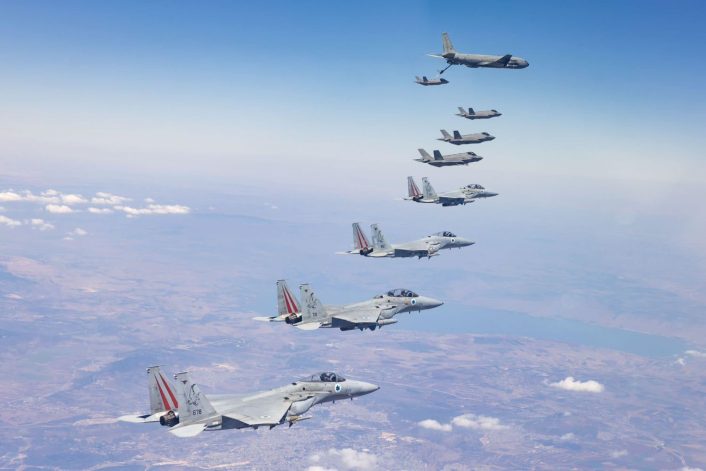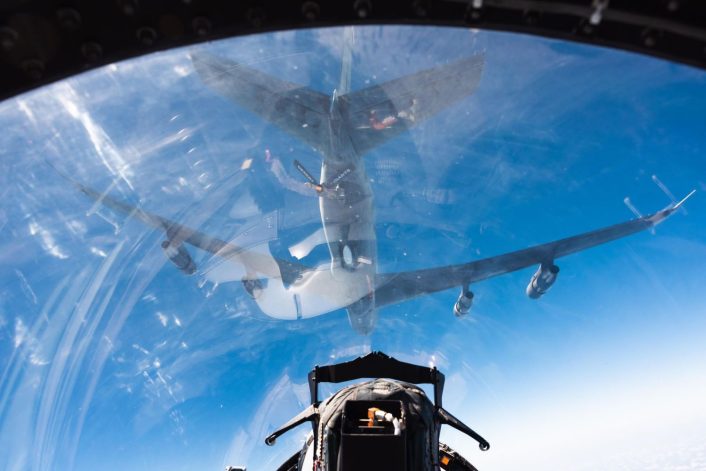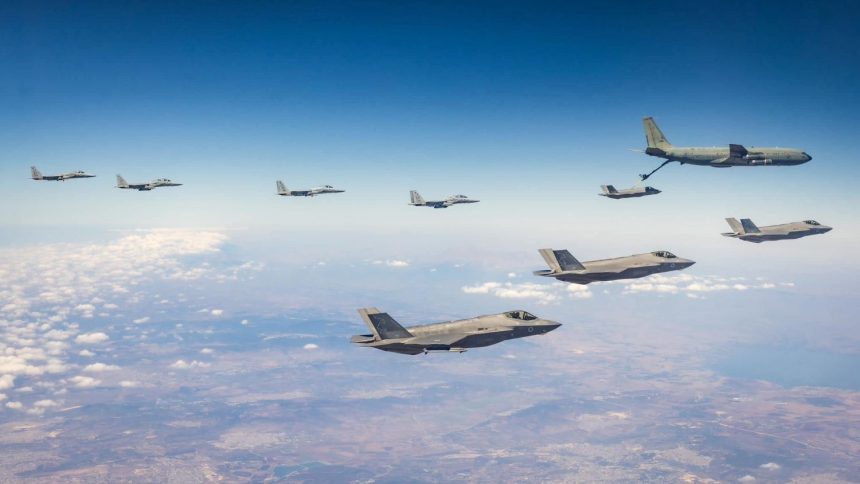Israel flexes its aviation muscles as tensions with Iran soar, with an exercise simulating “a long-range flight deep in enemy territory” supported by aerial refueling.
On Aug. 15, 2024, the Israeli Air Force carried out an air refueling exercise involving their 707 “Re’em” tankers and F-35I “Adir” and F-15C/D “Baz” fighters. One extremely rare aspect of the exercise was that the receiver aircraft were all armed with live weapons.
“The exercise simulated long-range flight deep behind enemy lines, performing aerial refueling in short periods of time. Aerial refueling is an operational capability required by the combat force, enabling it to remain airborne for long periods of time,” mentioned the social media posts made by the Israeli Air Force.
The exercise
In images released by the Israel Defense Forces, the IAF shows off a variety of weapon systems. The McDonnell Douglas F-15C “Baz”, the single-seat variant of the most successful fighter aircraft of all time, is shown carrying GBU-31 Joint Direct Attack Munitions (JDAM) while the F-15D (two-seat model) carries the AGM-142 “Popeye”. The AGM-142 is an Israeli-produced air-to-surface standoff missile while a JDAM is a kit to turn a “dumb” (or unguided) bomb into a precision munition.
Notably, although they are simulating a long-range strike mission, the F-15s are not equipped with their usual 600 gallons external fuel tanks. That’s because the stations 2 and 8, under the wings, are loaded with the heavy weapons and the centerline station (5) of the twin seaters is loaded with the Popeye’s data link pod.
In apparent preparations for a potential strike in Iran, the Israeli Air Force yesterday conducted a long-range refueling exercise.
In a statement, the IDF says the drill “simulated a long-range flight deep in enemy territory, while conducting aerial refueling several times in… pic.twitter.com/w7mq8YZELV
— Emanuel (Mannie) Fabian (@manniefabian) August 16, 2024
However, the Bazs are equipped with the Conformal Fuel Tanks or FAST packs (Fuel And Sensor Tactical), usually seen on the F-15E Strike Eagle and F-15I Ra’am, which can carry 750 gallons of fuel while retaining six mounting points for weapons and the two for the sensors.
Unlike standard external fuel tanks, the FAST packs can’t be jettisoned inflight, however they do not affect excessively the performance of the F-15. In fact, they allow the same maneuverability without g-load limitations, with only a structural restriction to not exceed Mach 2 (the reported max speed of the F-15 is Mach 2.5).

In the released images we also see Israel’s newest fighter, the F-35I “Adir”, flying in “full stealth mode” without radar reflectors. Notably, the Israeli Air Force has previously claimed their F-35s can reach Iran without refueling. The claim was vague and without many details, but it was assumed to be in reference to new, “stealthy” drop tanks or conformal fuel tanks (CFT).
It is no secret that the Israeli Air Force considers the combat range as one of the most important factors when adopting a new fighter aircraft and that, because of this, it was the first operator to ask for external fuel tanks for the F-35 Lightning II. The new alleged tanks, however, have never been publicly shown and details have never been released.
Also of note, one of the F-35s is also seen carrying an AIM-9X Sidewinder air-to-air missile on an external rail. The “Adir” claimed its first air-to-air recently by intercepting a Houthi cruise missile in 2023. Even more recently, the fighters were involved in Israel’s first ever strikes in Yemen in a retaliatory strike on Houthi forces.
As for the tanker – Israel’s Boeing 707s have been operating for around 60 years and will eventually be replaced by four brand-new KC-46A Pegasus refuelers. The 707s started life as commercial airliners and were converted to tankers locally later on. As with many of their assets, the IAF is very secretive of the exact capabilities and even number of KC-707s it operates.
הזרוע הארוכה של צה״ל: חיל-האוויר תירגל אתמול תדלוקים אוויריים של מטוסי קרב במרחב האווירי של ישראל.
התרגיל דימה טיסה בטווחים ארוכים בעומק שטח האויב, תוך תדלוק אווירי, מספר פעמים, בפרקי זמן קצרים. בתרגיל השתתפו מטוסי ״אדיר״, ״בז״ ומטוס “ראם” תדלוק אווירי. pic.twitter.com/LXYBaIy8pZ
— Israeli Air Force (@IAFsite) August 16, 2024
Aerial refueling is an extremely important part of modern military operations and Israel’s, even fighting in their own backyard, are no different. It has used a combination of purpose-built tankers like the KC-707, KC-130H, and historically the KC-97 with buddy-refuelers like the F-4E and A-4H among others.
While other details about the exercise were not disclosed, it appears to be similar exercise performed in the past years. For an instance, in 2022 the drills included “long-range flight, aerial refueling and striking distant targets,” with reportedly more than 100 aircraft participating in a 10,000 kilometers night long-range strike exercise, with the jets circling Cyprus and then conducting mock airstrikes in Israel.
In 2023, a similar exercise was held with the cooperation of Greece as part of a joint two-day drill. The Israeli strike package flew all the way to Greece, practicing low altitude flight and releasing live weapons on Greek training ranges, before flying all the way back to Israel.
The exercise comes at a time when the country (and the world) waits on the Iranian response to the assassination of Hamas leader Ismail Haniyeh in Tehran on July 31. Before that, as widely reported around the globe, was the large-scale Iranian attack on Israel with cruise missiles and “kamikaze” unmanned aerial vehicles (UAV) that was largely stopped thanks to American, British, and Jordanian involvement.

The Israel-Hamas War
Beginning on October 7, 2023, with a Hamas terror attack on a peace festival in Israel, the war has been raging ever since. The Israel Defense Force has been extensively covered by The Aviationist among many others for several “firsts”, such as F-35 involvement (like this article about F-35Is supporting ground troops with the use of 2,000 pound bombs) and analyses of operations with lesser-seen aircraft like the G550 “Oron”, Israel’s newest Intelligence, Surveillance, and Reconnaissance (ISR) platform, introduced in 2021.
The conflict has threatened to spill over into places like Lebanon, Iraq, and Syria several times since the start of the fighting. In the shadow of a larger conflict breaking out between Israel and Iran (and Hezbollah in Lebanon), there have been some attempts at peace talks that will hopefully bring the conflict to a close.
In anticipation of the new Iranian retaliatory attack, forces are on heightened state of alert, while additional US assets moved to the area both as a deterrent and to counter the possible attack. Among these are the twelve F-22s which were deployed from Alaska to the US CENTCOM (Central Command) area of responsibility.
The U.S. Navy is also preparing, with a guided-missile submarine ordered to the area and the USS Abraham Lincoln Carrier Strike Group told to accelerate the arrival in the Middle East. In the last few months, the USS Dwight D. Eisenhower has been busy intercepting Houthi attacks against military and commercial vessels in the region, striking Houthi positions and rescuing personnel from attacked vessels.









